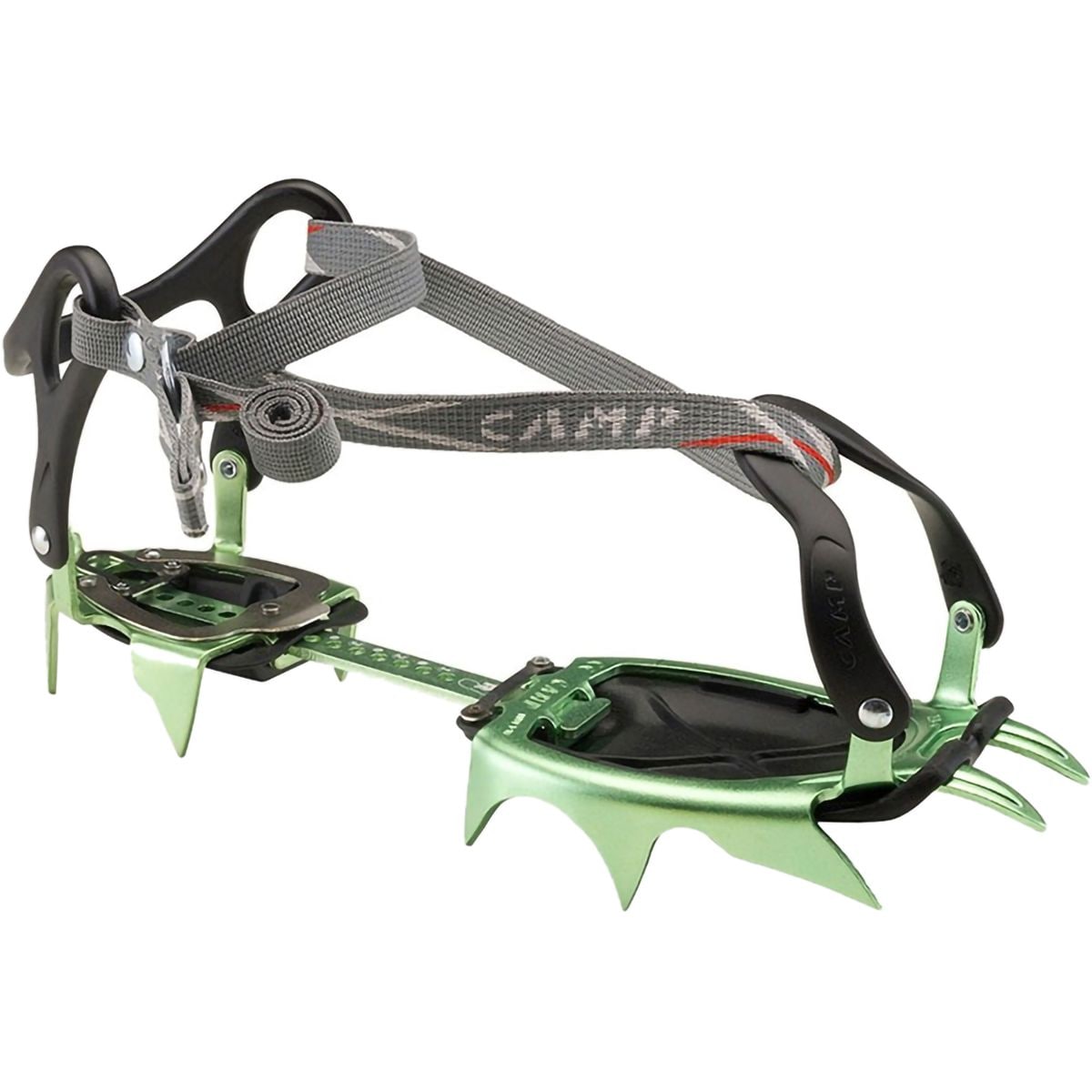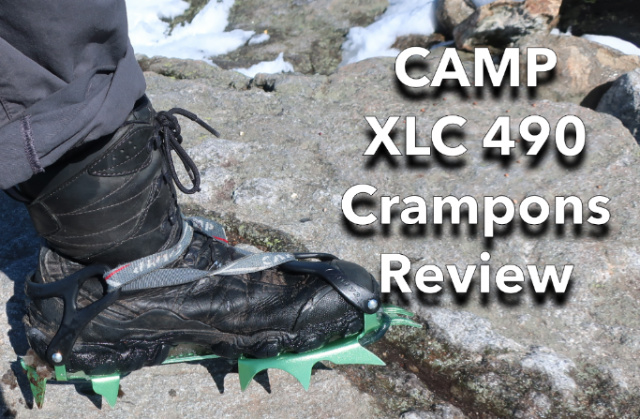CAMP XLC 490 Crampons are lightweight aluminum crampons with a universal binding that are compatible with most mountaineering and hiking boots. They’re designed for low-angle hiking on ice and packed snow, often called glacier travel. While aluminum crampons aren’t as durable as ones made with steel, they are far lighter weight, which makes them easier to use and easier to carry, especially on long winter hikes when you don’t know whether you’ll need them or not.
Specs at a Glance
- Weight: 585 g / 20.7 oz (actual 610 g)
- Binding: Universal
- Adjustable length: Tool-free
- Anti-balling plates: Yes
- Number of spikes: 12
- Spike Length: 3 cm
- Material: 7075 Aluminum alloy
Low-Angle Crampons
Hikers have a lot more options today than they did 10-12 years ago when you needed to wear heavy steel crampons and mountaineering boots for winter hiking. Since then there’s been a revolution in insulated footwear and lightweight traction devices such as microspikes and traction aids designed for flexible soled shoes including trail runners. In fact, there are so many options that it can be difficult for new winter hikers to choose between them.

But these CAMP Crampons aren’t your everyday winter hiking spikes and are best used on low-angle ice and packed snow (often referred to as glacier travel) high up on a mountain, where you want deeper penetration for hiking uphill or coming back down a slippery slope. Low-angle means non-vertical, more like a slope angle of 40 degrees or less. These also aren’t crampons that you’d use for ice climbing or general mountaineering where you want a very rigid and durable steel crampon for kicking the front spikes into very steep or vertical ice.
I mainly use these CAMPs for descending steep ice-covered hiking trails where I want more braking and traction than I can get from a pair of Hillsound Pro Crampons, Kahtoola K10s, or Kahtoola KTS crampons because they have much longer and sharper spikes. I also use them for hiking on icy or slushy trails where the snow balls-up (clumps together in the crampon teeth so you lose all traction) because they have anti-balling plates that prevent it. Lately, I’ve been using them on slopes that are covered with slush that lies on top of hard ice. I feel like I get a much deeper bite into that hard icy layer under the slush with the XLC 490’s longer crampon teeth.

Universal Binding
The CAMP XLC 490 Crampons have a universal binding, which means that they’re compatible with any kind of boot that is stiff enough to support a crampon (more on this below.) Universal bindings have two plastic cages, called bails, one at the toe and one at the heel. These cup your heel and toes and are held on with a strap threaded through holes in the bails. The strap is threaded in the shape of a triangle, running up through the nose, around the opposite side of the heel, and then secured with a double ring buckle. I pull on the strap so it’s tight but still comfortable and then knot up the loose end so I don’t trip on it with the spikes on my other foot.

The XLC 490 does not have a flexible leaf spring: that’s the thin metal bar that connects the front and the rear halves of the crampon. The length of that center bar is adjustable without tools, using a manual spring mechanism to lock the sizing in place. While it’s rigid aluminum, there’s a risk that it can bend if you wear the XLC 490s with boots that have very flexible soles. Even then the bar is unlikely to break and replacements are available, but I would avoid pushing your luck and avoid using the XLC 490 with soft-soled boots. I wear these crampons with a 400-gram non-rigid, single-layer, insulated winter boot called the Oboz Bridger 10″ and my bar hasn’t bent, but YMMV.

Durability
Aluminum crampons are not as strong or as durable as steel crampons. While you can use them in mixed conditions with rock and ice, I’d recommend minimizing their use on rock since it will dull the points if you do it frequently. Rock is unavoidable sometimes so you need to check your points periodically to see if they’re dull. That said, you’d be surprised how much traction you can get with worn-down spikes, simply be using your body weight to push the spikes into ice or snow. Microspikes work the same way but have much smaller spikes.

These crampons can be sharpened with a mill bastard file, but you can only do that one or two times with aluminum crampons because they have less mass compared to steel. The XLC 490’s have an embossed figure on the side that shows you what the points should look like when sharpened (as sharp as the tip of a ballpoint pen is a good target) and how far you can sharpen them before they need to be replaced (the upper “V”).

Comparison with Hillsound Trail Crampon Pro’s
Hillsound’s Trail Crampon Pros are similar to these XLC 490’s in terms of utility and range, although they are a few ounces heavier and they have carbon steel spikes instead of aluminum ones. The Pro’s also come with anti-balling plates and don’t require tools to adjust, but they have 10 points compared to the 12 points on the XLC 490 and shorter spikes (see bullets below). The other difference is the ratchet bindings, which are much simpler to use on the Pro than a Universal Crampon Binding, particularly for inexperienced winter hikers. I recommend the Pro much more often than the XLC 490 for this reason.
- Steel vs Aluminum Crampons Compared
- CAMP XLC 490 Crampons: 20.7 oz (585 g)/pair, aluminum, 12 points, spike length – 3 cm
- Hillsound Trail Crampon Pro: 23.5 oz (667 g)/pair, steel, 10 points, spike length – 2.6 cm, 2 cm
- Black Diamond Contact Strap: 29 oz (808 g) /pair, steel, 10 points, spike length, 3 cm
But the biggest difference between the Pros and the XLC 490 has to do with skills. The XLCs are real mountaineering crampons (as are the steel BD Contact Crampons, noted above) and I recommend getting trained in the footwork techniques required to use them safely. Sliding falls in mountaineering crampons can result in a broken ankle or leg, but can be avoided with an hour’s worth of training and some practice. By comparison, most people can use Hillsound Trail Crampon Pros without any prior experience and they provide a good alternative to the XLC 490 in most conditions.

There’s another difference between the CAMP XLC 490s and the Hillsound Trail Crampons Pros and that is comfort, at least for me. The front straps on the Hillsound Pro’s exert a lot of pressure on my toes that I find uncomfortable when worn with my Oboz Bridger 10″ insulated boots. But the front toe bails on the XLC 490 crampons do not pressure my toes, so I prefer using them instead. I mention this because people with sensitive toes or feet may benefit from using a universal crampon binding.
Recommendation
CAMP XLC 490 Aluminum Crampons are a lightweight alternative to heavier steel crampons for hiking on low-angle ice or packed snow when aggressive traction and a longer spike length is warranted. They’re compatible with a wide range of mountaineering boots and non-technical hiking boots because they use a universal crampon binding, but they are full mountaineering crampons and require extra training to use safely. I first discovered aluminum crampons about 15 years ago and have been using them ever since with a variety of winter footwear from plastic mountaineering boots to non-rigid winter hiking boots. They are noticeably lighter on my feet than steel crampons and nimble to use.
While aluminum crampons are admittedly a niche product, they’re a good traction aid to carry when you think you might need them but don’t want to carry a heavier steel crampon. However, if you want a crampon that is simpler to use and requires less skill development, I recommend you try out the Hillsound Trail Crampon Pro, which is a big step up from microspikes and can be also used very much like the CAMP XLC 490 for walking on low-angle ice and snow slab.
Disclosure: The author owns this product.
Compare 2 Prices
-

 Amazon US$161.44View
Amazon US$161.44ViewAmazon.com Price: $161.44 (as of 04/22/2024 21:39 GMT-0400) Details
Product prices and availability are accurate as of the date/time indicated and are subject to change. Any price and availability information displayed on Amazon.com at the time of purchase will apply to the purchase of this product.
-

 Backcountry.com$169.95View
Backcountry.com$169.95View
 SectionHiker.com Backpacking Gear Reviews and FAQs
SectionHiker.com Backpacking Gear Reviews and FAQs 
Why is the strap twisted? Are you concerned about the knot you added freezing?
It just is, and no.
I picked up a pair of Camp Magix10 with the anit-bale. Very similar but they are steel, I think. Neat.
I have the Camp Stalker crampons and I often carry them in the winter and I rarely use them. I was interested in getting something lighter so I appreciate your review. I was wondering if you have tried or heard anything about the Petzl Irvis Hybrid. I have read you can add the back flex bar and people say they work on flexible boots. The front 6 point piece looks small though and not sure how it would be on larger flexible boots without a bar. They only look easier to pack than the XLC 490. By the way I am sure it is not a problem with your larger boots and it is not intuitive at all but I believe the instructions for the camp crampons show that the strap should go over the ankle, out to the toes and then connect to the ring lock. I think if you had a much smaller boot the ring lock could be on the curve of your ankle. I have read reviews of people complaining about them loosening up and I am guessing they have connected the strap incorrectly I did it wrong for quite a while.